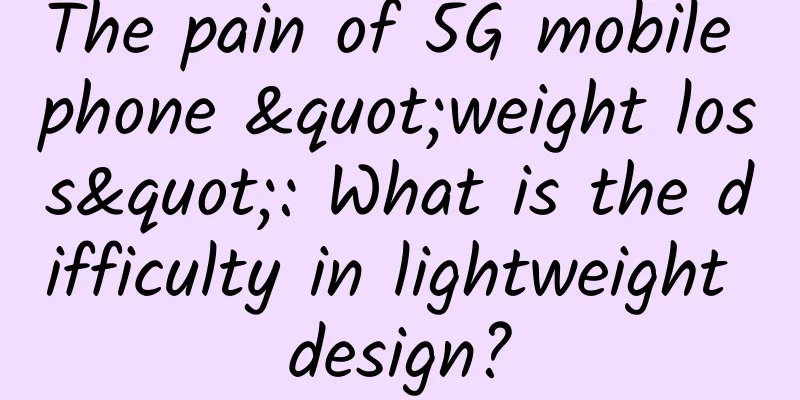The pain of 5G mobile phone "weight loss": What is the difficulty in lightweight design?

|
"The return of thin and light design is particularly evident in the second half of this year, especially as thin and light design plays an important role in manufacturers' publicity and selling points. If you carefully recall the changes in the “light and thin” design of 5G mobile phones, you will find that there is a lot of mystery behind it. 200g is the watershed for users to perceive the weight of a mobile phone
From the perspective of the evolution of smartphones: the weight of smartphones continues to increase. For example, the classic Motorola Defy model released before 2010 weighs 118g (a little heavier than two eggs, one egg weighs about 50g), and the Xiaomi 9 released in 2019 features a lightweight design and weighs 173g. In the period before 5G arrives, the direction of increasing mobile phone weight is: larger batteries and batteries, better appearance, more powerful cameras, etc. Reasonable technology can also keep the weight of mobile phones within a reasonable range. The pain of 5G mobile phone "weight loss": What is the difficulty in lightweight design? The Xiaomi Mi 9 weighs 173g. Before the advent of 5G technology, people’s weight bottleneck for smartphones was 200g. 200g is a psychological and physiological hurdle for ordinary users. Psychologically, people think that a 200g phone with a protective case and tempered glass will be heavier to use; Physiologically, the weight of 200g is roughly equivalent to four eggs. Holding a phone of this weight with one hand for a short period of time will not be too much of a burden. However, it will still be heavy to hold for a long time to watch videos, play PUBG, or spray pesticides. However, the fact that 5G requires more components has accelerated the weight gain of mobile phones . In order to maintain the user experience in all aspects, many 5G mobile phones have to lower the priority of "lightweight" design. 5G mobile phones that start at 200g are daunting for many users. Fortunately, the current thin and light 5G mobile phones have a weight control of about 180g, which has a great impact on users both psychologically and in daily use. It can be said that consumers have already accepted the established fact that "5G functions will increase the weight of mobile phones" and have also accepted that "making 5G mobile phones thin and light requires a lot of technical content." So, what are the technical difficulties in making 5G mobile phones thin and light? Why is it difficult to make 5G mobile phones “light and thin”? What we need to understand is that there is a natural contradiction between rich functions and thin design on smartphones. This natural contradiction is particularly obvious in the 5G era. First, the contradiction between thinness and battery life . Long battery life is one of the necessary conditions for users to have a satisfying 5G experience. Especially when the current 5G power consumption problem has not been completely solved, battery life has a higher priority for users than thin and light design. Therefore, the battery capacity of many new 5G phones is generally larger. If you place too much emphasis on the thin and light design of your phone, the first thing you need to compromise on is battery life. Secondly, the contradiction between 5G function and thin and light design. The realization of 5G functions requires the integration of more components and antennas inside the mobile phone. The number and power consumption of these 5G components have been significantly increased. If the mobile phone emphasizes too much on thin and light design, it will affect the 5G experience. Take the Redmi K30 Pro as an example. In order to realize the 5G function, the amount of components has been greatly increased, making the arrangement of components on the mobile phone motherboard extremely complicated. The pain of 5G mobile phone "weight loss": What is the difficulty in lightweight design? Furthermore, there is the contradiction between high-quality screen and thin and light design. In order to increase the selling points of 5G mobile phones, they often use higher-quality screens. These screens have visible improvements in parameters such as color display, screen size, and screen refresh rate. However, the realization of these functions often requires sacrificing some battery life as a compromise. In addition, there is the contradiction between powerful imaging capabilities and thin and light design. The imaging system of 5G mobile phones needs to occupy a certain amount of space and weight in the mobile phone. While we are using the improvement of mobile phone imaging systems, we are also accepting the fact that the weight and volume of mobile phones are getting larger and larger. To a certain extent, the weight of a mobile phone is positively correlated with the user experience. Especially for 5G mobile phones that need to take into account more and more functions, manufacturers need to put forward extremely high requirements on the stacking technology inside the mobile phone, especially the battery technology that restricts the evolution and development of the mobile phone form. Therefore, it is not easy for the current thin and light 5G mobile phones to control the weight to around 180g while ensuring long battery life. |
>>: The "Six Mountains" that Block Operator Innovation
Recommend
RhinoTech: Dedicated servers seckill + 20% off starting at $24.5, US/Japan/Korea data centers
RhinoTech sent an email yesterday about its Augus...
How to understand 5G air interface (NR)?
The telecommunications industry certainly hopes t...
Learn Python network programming from scratch: Explore TCP protocol and example demonstrations!
Python is a high-level programming language with ...
LiteServer New Year Promotion: 2GB RAM NVMe hard disk package from €3/month, 512G large hard disk VPS from €3/month
LiteServer is a foreign hosting company founded i...
GreenCloudVPS: $30/year 500G hard drive VPS, 10Gbps bandwidth, Singapore (non-direct connection) data center
GreenCloudVPS recently installed new machines in ...
inetWS: $3/month KVM-2GB/30G SSD/100M unlimited traffic/13 computer rooms available
inet.WS has released a 25% discount coupon code f...
How does the gateway record request response logs in SpringCloud microservices?
Hello everyone, I am Piaomiao. In microservices d...
Facing the information gap brought by the 5G era
South Korea is expected to launch 5G (fifth-gener...
5 exciting 5G use cases
As the fifth generation of wireless technology, 5...
H.266 codec standard released to replace H.265/HEVC: video clarity remains unchanged, data volume is halved
This week, Fraunhofer HHI officially announced th...
The latest version of WeChat has been updated to fix these problems
According to the normal update rhythm, WeChat iOS...
Gartner predicts that global IT spending will reach $4 trillion in 2021
Gartner, the world's leading information tech...
From the practice of operators, why "intelligent multi-cloud" has become the key to the success of cloud strategy
If the symbol of the second industrial revolution...
NB-IoT is no longer popular, will 5G repeat its mistakes?
The current situation of NB-IoT (hereinafter refe...









